Exploring Woodpecker Scare Tape for Effective Pest Control

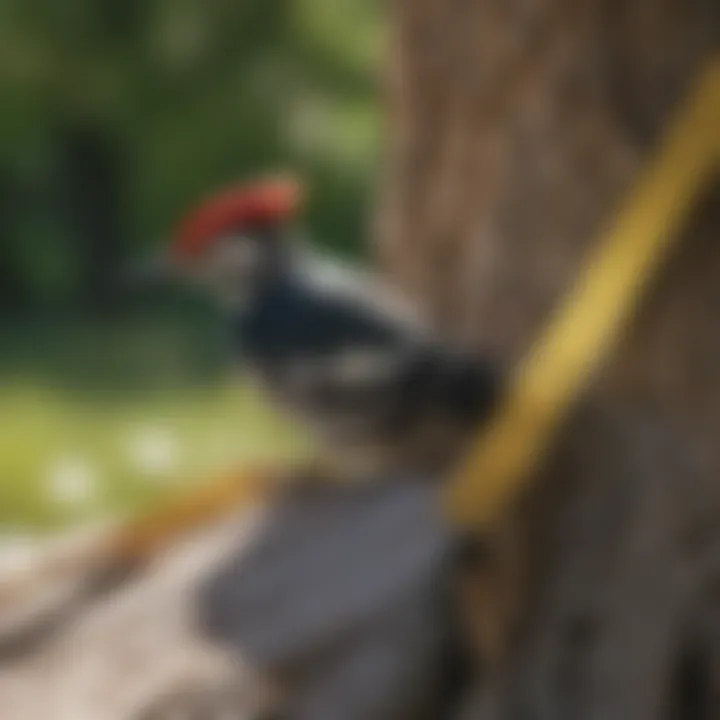
Intro
In residential spaces, especially in nature-rich environments, the presence of pests can be a notable concern. One such pest that frequently draws attention is the woodpecker. While these birds are often admired for their striking appearance and unique behavior, they can cause significant damage to homes and properties. This article looks at an emerging solution: woodpecker scare tape. Understanding its role in pest management can be crucial for homeowners who seek effective yet humane methods to deter unwelcome visitors.
The following sections will explore the underlying factors associated with woodpecker behavior, preventive measures that can be enacted, and a thorough examination of eco-friendly pest control options. This comprehensive approach will equip homeowners with vital insights, allowing them to manage woodpecker activities effectively while maintaining a respect for the natural ecosystem.
Understanding Pests
Definition of Pests
Pests are organisms that either cause damage to crops, homes, or other properties or pose a threat to human health. They generally reproduce quickly and can be challenging to control once established. Woodpeckers, specifically, fall into a category of avian pests, where their foraging behaviors lead to destructive pecking on wooden structures. Understanding them as pests requires addressing both their ecological role and the problems they cause in human habitation.
Importance of Pest Identification
Identifying woodpeckers as pests is the first step in targeting their management. Knowing the species and behavior of the woodpecker in a given area is vital. For instance, the Downy Woodpecker and the Northern Flicker have different habits and preferences. This identification assists homeowners in selecting the right deterrent strategies.
"Accurate identification of pests allows for tailored approaches to pest management, leading to enhanced effectiveness."
Prevention Techniques
Home and Garden Preventative Measures
Preventing woodpecker damage often requires a multi-faceted approach. Here are several strategies that homeowners can employ to minimize the risk of woodpecker intrusion:
- Visual Deterrents: Methods like reflective woodpecker scare tape can effectively swirl light and movement, making environments less appealing.
- Physical Barriers: Installing mesh or wire over vulnerable areas on the building can prevent access to woodpeckers.
- Noise Makers: Wind chimes or other gentle sounds can displace woodpeckers from targeted zones.
Seasonal Prevention Tips
Understanding the seasonal habits of woodpeckers can also inform prevention techniques. For example, during spring, when woodpeckers are establishing territories, most aggressive behaviors are noted. Homeowners can take proactive measures during this period. Using scare tape and visual barriers can be particularly effective as these birds are visually oriented.
Eco-Friendly Pest Control Solutions
Overview of Sustainable Practices
Modern pest management increasingly emphasizes sustainability. Eco-friendly solutions not only address immediate concerns but also consider long-term ecological impact. Approaches such as habitat modification, combined with deterrents like woodpecker scare tape, exemplify this trend. By creating environments less hospitable to pests, homeowners can naturally reduce their presence without resorting to harmful chemicals.
Natural Remedies and Their Effectiveness
There are various natural remedies that can complement the use of woodpecker scare tape. These may include:
- Essential Oils: Some oils, like peppermint or citronella, can create a barrier that discourages woodpecker activity when applied strategically.
- Homemade Sprays: Mixtures of vinegar and water can impart scents that require woodpeckers to move away, although this may require constant reapplication.
The effectiveness of these methods can vary, thus combining them with woodpecker scare tape is advisable to enhance overall impact.
Prelude to Woodpecker Scare Tape
Woodpeckers can be charming birds, but their presence can lead to significant property damage. The sound of pecking is hard to ignore. Understanding how to manage this issue can help homeowners protect their properties. Woodpecker scare tape has gained attention as a practical solution to deter these birds. This introduction will outline the relevance of this method as a pest management strategy.
Using scare tape offers several advantages. It is non-toxic, easy to install, and can be effective without employing harmful chemicals. Additionally, it is a cost-effective way to address the problem, making it appealing for budget-conscious households. By understanding woodpeckers and implementing scare tape effectively, owners can minimize damage while remaining environmentally responsible.
Understanding the Problem of Woodpeckers
The woodpecker issue lies in its habits. These birds often drill into wooden structures for food or nesting purposes. The pecking can cause unsightly holes and weaken the structural integrity of homes. This problem is not just cosmetic; it can lead to expensive repairs. Common species causing trouble include the Downy Woodpecker and the Hairy Woodpecker.
Seasonal behavior also influences the damage. Spring often sees woodpeckers establishing territories, leading to increased activity. Homeowners need to be proactive and informed about timing and potential risk factors related to woodpecker behaviors.
What is Woodpecker Scare Tape?
Woodpecker scare tape is a reflective, shiny tape made from durable materials. It is designed to scare away birds through visual and auditory distractions. The tape flutters in the wind and glimmers in the sunlight, catching the birds’ attention.
The application is straightforward. It involves hanging the tape around areas prone to woodpecker activity. Many users find that strategic placement significantly reduces bird encounters. While it does not harm the birds, it provides an effective deterrent that capitalizes on their natural instincts to avoid potential threats.
"Woodpecker scare tape is a simple yet effective method that blends ease of use with positive results in pest management."
Ultimately, understanding both the problem and the basic functionality of scare tape is vital. In the following sections, we will delve deeper into its mechanisms of action and the best practices for implementation.
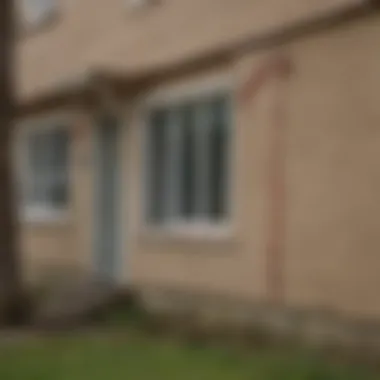
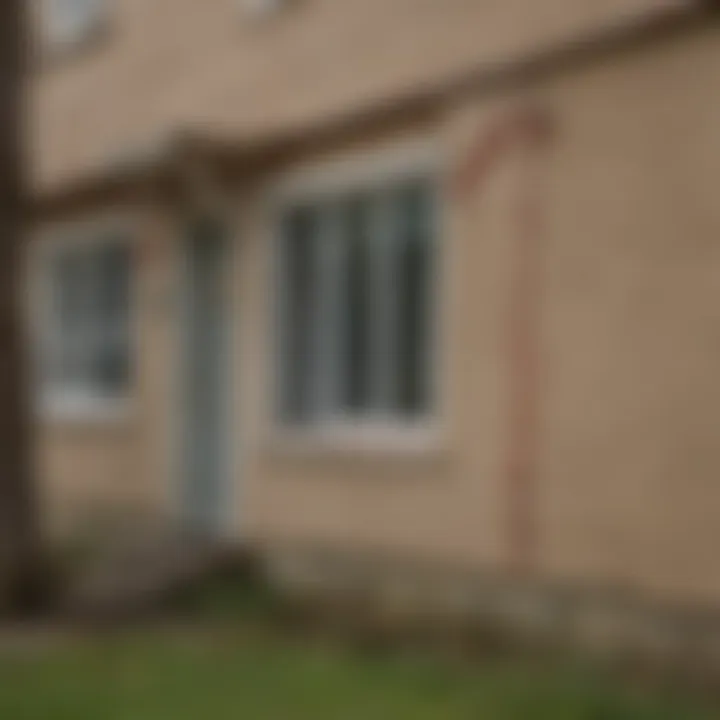
The Mechanism of Action
Understanding the mechanism of action of woodpecker scare tape is essential for homeowners and pest control professionals looking to mitigate the damage caused by woodpeckers. This section sheds light on how this tool operates, its underlying principles, and the behavioral changes it prompts in woodpeckers. By grasping these concepts, users can effectively implement scare tape strategies, ensuring improved pest management efforts with less reliance on harsh chemicals or invasive methods.
How Scare Tape Works
Woodpecker scare tape is designed to deter these birds through simple yet effective means. The tape is typically reflective and shimmery, capitalizing on visual stimuli to create an environment that is perceived as threatening or hostile to woodpeckers. When the tape is installed in areas frequented by the birds, it catches light and generates erratic reflections, which can alarm them.
The installation process is straightforward. It involves attaching strips of the tape in strategic locations around homes, which may include trees, wooden fences, or the sides of a house. It does not require specialized tools or skills, making it accessible for an average homeowner.
Here are some key points about how this tape works:
- Light Reflection: The shiny surface reflects sunlight, creating unpredictable reflections that can confuse woodpeckers.
- Movement: Wind may cause the tape to move, generating sounds that further deter woodpeckers from approaching.
- Simplicity: Unlike other deterrent strategies that may involve power sources or maintenance, scare tape is passive, functioning effectively without constant monitoring.
By deploying woodpecker scare tape, individuals can create a less inviting environment, thereby protecting their properties from potential damage.
Psychological Effects on Woodpeckers
The effectiveness of woodpecker scare tape does not rely solely on its physical presence. The psychological effects on woodpeckers are equally significant. These birds have evolved to avoid threats in their environment. When they encounter stimuli that seem abnormal or threatening, their natural instinct is to retreat.
Specifically, the following psychological impacts can be noted:
- Fear Response: The reflective surfaces can trigger a fear response in woodpeckers, causing them to associate the area with danger.
- Habituation Resistance: Unlike static objects, the movement and light emissions from scare tape can prevent woodpeckers from becoming accustomed to their presence.
- Buffer Zones: Over time, woodpeckers may instinctively avoid areas marked by scare tape, resulting in a natural buffer zone around property.
"The psychological deterrence provided by woodpecker scare tape exemplifies a non-invasive method of pest control that aligns with natural aversion behaviors inherent in wildlife."
In summary, the mechanism of action behind woodpecker scare tape combines physical and psychological elements. This dual approach enhances its utility and efficacy in pest management strategies, making it a valuable tool for home and property owners.
Products Available on the Market
The availability of woodpecker scare tape is crucial for effective pest management. Understanding the different products can guide homeowners in selecting the right option that fits their needs. Each type of scare tape has unique features that cater to various situations and preferences. Moreover, analyzing the offerings in the market enables homeowners to make informed decisions, ensuring they invest in a product that provides optimal results.
Types of Woodpecker Scare Tape
There are primarily two types of woodpecker scare tape available: reflective tape and sound-emitting tape.
- Reflective Tape: This type of tape employs shiny, reflective surfaces that glimmer in sunlight. The brilliant flicker is unsettling to woodpeckers, causing them to search for food elsewhere. Reflective tape is often made from materials like plastic or mylar, providing durability and effectiveness in various weather conditions.
- Sound-Emitting Tape: Unlike reflective options, sound-emitting tapes have features that produce noise when wind passes through them. This sound can mimic natural disturbances, creating an uncomfortable environment for woodpeckers. The audio component adds another layer of deterrence, making it more likely for woodpeckers to avoid treated areas.
Both types of tapes are generally easy to install and can be used in various settings, such as residential properties, gardens, and commercial spaces. Choosing between these types depends on the nature of the infestation and personal preferences.
Evaluating Different Brands
When selecting a specific brand, it is essential to consider several factors. The performance, durability, and user feedback about each brand can significantly influence its effectiveness. Some popular brands include Bird-X Scare Tape and Squirrel Stopper.
- Performance: Review the clarity of the product’s features. Good brands are known for their effectiveness and longevity, which can save homeowners from frequent replacements.
- Durability: Check user reviews concerning how the tape withstands various weather conditions, such as wind, rain, or high temperatures. Durable products ensure that homeowners do not face continuous replacement issues.
- User Feedback: Engaging with other users' experiences on platforms like Reddit can be valuable. Homeowners often share their success stories as well as challenges, helping potential buyers gauge the efficacy of different brands.
Evaluating the market thoroughly not only enhances understanding but also contributes to better pest management strategies. By making informed choices, homeowners can achieve a balance between aesthetic concerns and efficient woodpecker deterrence.
Application Techniques
The application techniques for woodpecker scare tape are crucial in maximizing its effectiveness. Proper application methods can significantly influence the outcomes homeowners experience when trying to deter these birds. Each technique should be considered as part of a comprehensive strategy. Thus, understanding how to effectively place the tape and the appropriate duration for which it should be used is vital for pest management success.
Effective Placement Strategies
When using woodpecker scare tape, placement is key. The tape should be installed at locations where woodpeckers are most likely to approach, such as on trees, siding, or fences. It is important to select areas that will be highly visible to the birds. Placing the tape too high or too hidden will reduce its effectiveness.
- Visibility: The tape should be positioned so that it catches the light, reflecting it in a way that attracts the attention of woodpeckers. Using multiple strips can enhance visibility.
- Movement: Wind movement can amplify the scare effect. Choosing placement areas where the tape can flutter easily, such as near openings or on loose, movable surfaces, can create additional deterrent effects.
- Height and Angle: Position the tape at a height similar to where woodpeckers typically peck. An angle that directs the tape toward their line of sight can further enhance its visibility.
Each of these factors contributes to creating an area around the targeted surface that feels less safe for the woodpeckers, encouraging them to seek food sources elsewhere.
Duration of Use
Determining the right duration for which woodpecker scare tape is left in place is equally important. Prolonged usage can lead to diminishing returns. The birds may become accustomed to the sight of the tape, reducing its effectiveness significantly over time.
- Initial Period: It is best to maintain the tape in place continuously for at least a few weeks after installation to allow the deterrent effects to take shape.
- Periodic Assessment: Homeowners should monitor the area regularly to assess the efficacy of the scare tape. If woodpeckers continue to approach or show signs of establishing routine visits, it might be time to replace or reposition the tape.
- Rotation Strategy: To prevent birds from becoming habituated, consider using the tape in conjunction with other deterrent methods or rotating it with other visual deterrents. This can involve using the scare tape for a few weeks and then replacing it with reflective objects, such as aluminum foil or shiny balloons.

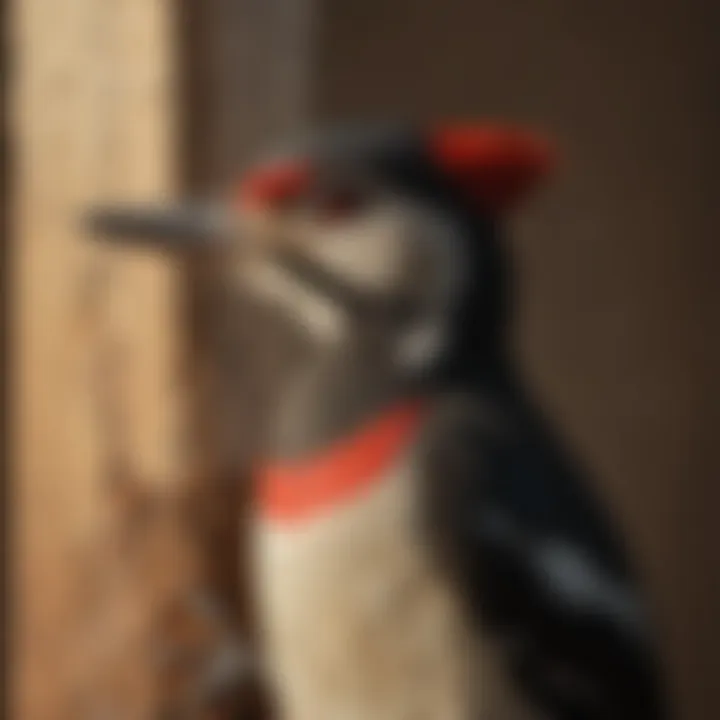
Adhering to these techniques can optimize both the placement and duration, ensuring that the woodpecker scare tape serves its purpose effectively, protecting properties from potential damage.
Efficacy of Scare Tape in Pest Management
The effectiveness of woodpecker scare tape as a pest management tool is essential. It provides a solution for homeowners facing issues caused by woodpeckers. These birds can cause significant damage to buildings and trees, which can be costly to repair. Implementing effective solutions is vital for maintaining property integrity without resorting to harmful methods. Scare tape stands out as a non-lethal option. Its efficacy is determined by various factors.
Studies and Data on Effectiveness
Several studies have investigated the effectiveness of woodpecker scare tape in deterring these birds. Research indicates that reflective materials used in scare tape create visual distractions. This forces the woodpecker to perceive the area as risky for their activities. In one study conducted by a regional pest control organization, data showed that properties using scare tape experienced a 60% reduction in woodpecker-related damage over a single breeding season.
Feedback from homeowners revealed that the placement of scare tape at strategic locations, such as eaves and tree trunks, significantly enhanced its effectiveness. Moreover, data from user surveys highlighted that most users observed initial success, though some woodpeckers returned after a period. To maintain efficacy, it is crucial to reposition the tape occasionally or replace it as its reflective properties diminish over time.
Comparative Analysis with Other Deterrents
When examining woodpecker scare tape, it is beneficial to compare it with other deterrent methods used for pest management. Common alternatives include noise-based deterrents, physical barriers, and chemical repellents.
- Noise-based deterrents often utilize sounds that may disrupt the birds. While somewhat effective, these methods can be inconsistent and potentially disturb human occupants.
- Physical barriers, such as mesh wiring, can also provide protection but are not visually appealing and may require significant installation efforts.
- Chemical repellents pose risks for environmental contamination and may not be suitable for all homeowners.
In comparison, woodpecker scare tape is more appealing due to its low maintenance and ease of use. It requires minimal installation and can be reused in different locations. Homeowners find it economical, as a single roll can cover considerable areas.
User Experiences and Feedback
User experiences and feedback are critical components when evaluating any pest management solution, including woodpecker scare tape. Understanding how this tape performs in real-world scenarios offers valuable insights that scientific data alone may not provide. Homeowners often share their stories about effectiveness, failures, and the nuances that come with various applications.
When people apply woodpecker scare tape, they are looking for a solution that is not only effective but also easy to use and safe for the environment. This feedback may help others make informed decisions. Additionally, homeowners can highlight specific strategies they employed, leading to either success or challenges. All these factors contribute to a more comprehensive understanding of scare tape's role in pest management.
Case Studies of Successful Application
Several case studies provide a glimpse into how woodpecker scare tape has been successfully implemented across different settings. For instance, a family living near a wooded area reported significant damage to their home’s siding due to persistent woodpecker activity. After applying scare tape around the affected areas, they observed a marked reduction in woodpecker visits. They strategically placed the tape where the birds frequented, such as near the eaves and on sections of siding exhibiting damage.
Another example comes from a homeowner who was troubled by woodpeckers targeting their wooden deck. After installing scare tape, they noted a quicker disappearance of the birds. In both cases, the stories show that individual experiences can support the notion that woodpecker scare tape may indeed reduce unwanted interactions with these birds.
Common Challenges Encountered
Even with successful applications, some users face challenges when using woodpecker scare tape. One common issue noted by several homeowners is the durability of the tape. Some have discovered that the tape can easily become loose or lose its effectiveness over time, especially in areas with extreme weather conditions.
Another challenge is the variability in effectiveness. While some users see immediate results, others have reported a slow decline in woodpecker activity, suggesting that the scare tape alone may not be a comprehensive solution. Understanding that different environments and situations may yield differing results helps set realistic expectations for potential users.
"Real-life experiences reveal insights that studies sometimes miss. Practical application often tells a different story."
Finally, placement of the tape itself can lead to mixed results. Inconsistent application can contribute to effectiveness. Homeowners may need to experiment with placement and duration of use to find the most effective strategy for their specific situation.
In summary, user experiences reveal a spectrum of outcomes with woodpecker scare tape. They highlight both successful applications and the challenges that come with using it. This invaluable feedback offers potential users guidance on what they can expect when considering this solution.
Environmental Considerations
The environmental implications of using woodpecker scare tape are significant. Understanding these considerations helps homeowners and pest control professionals make informed decisions. As pest management practices evolve, the importance of eco-friendliness cannot be overstated. This section explores the non-toxic aspects of scare tape and its potential impacts on local wildlife, ensuring that pest control strategies align with environmental sustainability.
Non-Toxic Nature of Scare Tape
Woodpecker scare tape is designed to deter these birds without causing harm. Made primarily from plastic or reflective materials, it does not contain toxic substances. This aspect is crucial for homeowners who prioritize the health of their property, family, and surrounding ecology.
Using non-toxic deterrents reduces the risk of chemicals leaching into the environment. Such measures protect not just woodpeckers but also beneficial birds and other wildlife. Non-toxic solutions are particularly valuable in urban areas where wildlife interaction is frequent. They allow for effective pest management without sacrificing ecological integrity.
Advantages of the non-toxic nature of scare tape include:
- Safety for Children and Pets: Homeowners can feel secure knowing that their loved ones are not exposed to harmful chemicals.
- Preservation of Biodiversity: Non-toxic methods help maintain local ecosystems, aiding in the prosperity of multiple species.
- Regulatory Compliance: Many areas have regulations regarding the use of pesticides. Non-toxic methods, such as scare tape, often align better with these regulations, making it a practical choice for compliant pest management.
Impacts on Local Wildlife
While woodpecker scare tape is effective for deterring woodpeckers, it is important to evaluate its overall impact on local wildlife. The use of any deterrent must be carefully balanced to avoid unintentional consequences.
"Responsible pest management involves understanding the complex relationship between species in a given area."
One concern is that while the tape is harmless to woodpeckers, it may affect other birds and wildlife that inhabit the same areas. The bright colors and reflective surfaces can be confusing or distracting for some species. Care should be taken in areas where diverse wildlife is prevalent, ensuring that scare tape is not overly intrusive.
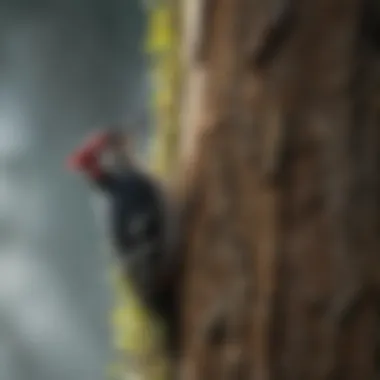
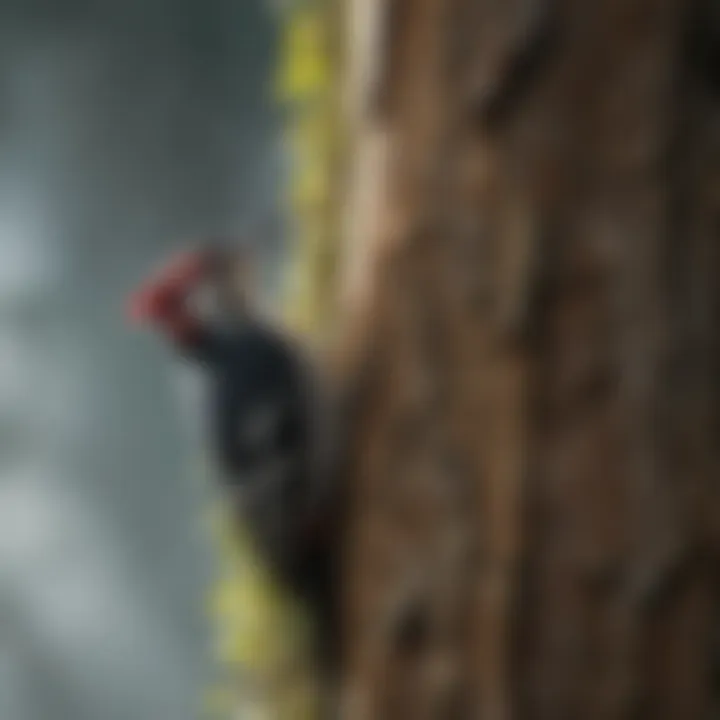
When deploying scare tape, here are some considerations:
- Monitor Usage: Regularly observe any shifts in local wildlife behavior. This will help identify if other species are negatively impacted.
- Strategic Placement: Avoid using scare tape in migratory pathways or near nesting sites to mitigate disruption to other bird species.
- Educate the Community: Raise awareness about the importance of using non-toxic, eco-friendly pest controls, and the impacts on local species.
Employing scare tape in a sustainable manner reflects a commitment to environmentally responsible pest management. It safeguards not only homes but also the natural habitats that support a rich diversity of wildlife.
Integrating Scare Tape into Comprehensive Pest Management Plans
Integrating woodpecker scare tape into comprehensive pest management plans provides a multifaceted approach to controlling woodpecker activities. This method is not merely about applying a deterrent; it is about creating a synergy between various strategies to achieve long-term success in pest control. Effective management requires understanding the behaviors of woodpeckers, the environment in which they operate, and how scare tape fits into this complex framework.
The use of scare tape offers several benefits when integrated with other techniques. For starters, it serves as a visual and auditory deterrent, creating an immediate sense of disruption in areas where woodpeckers tend to peck. By forming a part of a broader strategy, it enhances the overall effectiveness of pest control measures. This strategy may include physical barriers, habitat modification, and other forms of wildlife deterrents that, when used in conjunction with scare tape, amplify the results.
Considerations regarding the integration of scare tape into a pest management plan are essential. One must assess the specific characteristics of the property. Factors such as woodpecker species, local ecology, and existing disturbances play a significant role in determining the effectiveness of scare tape. Property owners should also be mindful of installation techniques, ensuring the tape is placed correctly to maximize visibility and sound. Regular rotation and replacement of scare tape are critical to maintaining its effectiveness, as woodpeckers may become accustomed to stationary deterrents over time.
Combining Techniques for Optimal Results
A multifaceted approach is often the most effective way to deter woodpeckers. This involves combining scare tape with other methods that create a more hostile environment for the birds. For instance:
- Visual Deterrents: Complementing scare tape with reflective surfaces or objects can disorient the birds further.
- Sound Devices: Using sound-producing devices alongside scare tape helps maximize psychological effects, disrupting the local soundscape that woodpeckers rely on.
- Physical Barriers: Installing mesh or netting around vulnerable areas adds a layer of protection, making it harder for woodpeckers to reach their intended targets.
Integrating these techniques increases the likelihood of reducing woodpecker activity significantly. Homeowners must remain vigilant and adaptable, as pest control measures may require adjustments based on compliance and environmental changes.
Long-term Solutions for Woodpecker Problems
Finding a long-term solution involves understanding that a single method of deterring pests may not suffice. The natural behavior of woodpeckers includes foraging for insects and creating nesting sites. Addressing the root causes, such as food sources and nesting preferences, is vital. This can include:
- Identifying and Treating Infestations: Regularly inspecting property for insect infestations can reduce the attractiveness of wooden structures.
- Habitat Modification: Making modifications to landscaping can discourage woodpeckers from frequenting the area. For instance, reducing the availability of trees that are conducive to nesting can help.
- Education and Awareness: Homeowners should educate themselves about local woodpecker species and their behaviors to develop better control strategies.
By fostering an integrated pest management plan that combines scare tape with long-term, proactive measures, property owners can effectively manage woodpecker issues. Over time, they will notice a significant reduction in damage, preserving the integrity of their properties.
"A well-thought-out pest management plan, encompassing various strategies, remains pivotal for effective control and prevention."
Ultimately, the journey towards effectively managing woodpeckers entails understanding their behavior, the environmental context, and being open to adjusting strategies as needed. The goal is to create a sustainable approach that minimizes conflict between homeowners and these interesting birds.
Future Trends in Pest Management Technologies
The landscape of pest management is constantly evolving. The development of new technologies provides innovative solutions to age-old problems. In recent years, advancements such as woodpecker scare tape have gained attention. These solutions not only target immediate issues but also align with broader environmental goals. Understanding future trends in this area helps homeowners and pest control professionals anticipate and adapt to changing methods.
Advancements in Scare Tapes and Deterrent Technologies
The effectiveness of scare tape has seen notable improvements. Manufacturers are now using high-quality materials that withstand various weather conditions. This increases the longevity and reliability of the product. Furthermore, some new scare tapes are designed with enhanced reflectivity. This property improves their ability to deter woodpeckers. They better capture and reflect sunlight, creating more visual disturbances than traditional tapes.
In addition, there is a trend towards incorporating technology into pest deterrence. Smart scare devices that integrate sound or motion sensors are emerging. Such innovations offer a new layer of effectiveness. They provide a proactive approach to pest management, allowing for real-time reactions to woodpecker presence.
Potential for Eco-Friendly Alternatives
As awareness of environmental sustainability grows, eco-friendly pest management solutions are becoming more prevalent. Woodpecker scare tape is notable for being non-toxic. This is a significant advantage when looking at pest control methods. Homeowners are increasingly aware of the potential impacts of chemical deterrents on local ecosystems. Eco-friendly alternatives minimize this risk.
The future may see even more biodegradable options entering the market. The use of natural materials in scare tape production is an area of interest. Innovations may lead to the development of fully compostable products. In addition, the concept of integrating scare tape with other sustainable practices could arise. For example, combining traditional birdhouses with scare methods could further deter woodpeckers without harming them.
"The evolution of pest management methods indicates a profound shift towards solutions that are both effective and environmentally responsible."
Overall, the future of pest management, especially with scare tapes, lies in the balance of effectiveness and ecological responsibility. Homeowners should stay informed about these developments to make educated decisions for their properties.
End
In summation, the usage of woodpecker scare tape represents a pragmatic approach to managing pest issues associated with woodpeckers. This article elucidates the efficacy of such deterrents by analyzing their mechanisms, applications, and environmental impacts. Understanding the interplay between woodpecker behavior and the design of scare tape can guide homeowners and pest management professionals in deploying this tool effectively.
Summary of Key Findings
The following points highlight the significant aspects discussed in this article:
- Effective Mechanisms: Woodpecker scare tape operates through visual and auditory stimuli, which can disrupt the birds' feeding and nesting activity.
- Market Options: Various products are available, each with unique characteristics. Evaluating brands based on user feedback and scientifically-backed evidence is crucial.
- Application Techniques: Proper placement plays a vital role in the efficacy of scare tape. Strategies include affixing tape near affected areas and using it consistently over time.
- User Experiences: Case studies reveal both successes and challenges encountered by homeowners, offering invaluable insights for future applications.
- Environmental Impact: The non-toxic nature of scare tape ensures safety for other wildlife, presenting a favorable alternative to more hazardous methods.
Recommendations for Homeowners
For homeowners facing issues with woodpeckers, consider the following recommendations:
- Assess the Situation: Before applying scare tape, identify the main areas of woodpecker activity to ensure targeted placement.
- Choose the Right Product: Research and select a scare tape based on efficacy reports and user reviews to find one that works best in your situation.
- Regular Maintenance: Continuously monitor the effectiveness of the scare tape. Replace or reposition it as needed to maintain its deterrent qualities.
- Integrate with Other Techniques: Combine scare tape with other pest management strategies to create a more comprehensive approach towards deterring woodpeckers.
By following these guidelines, homeowners can enhance their chances of protecting their properties from the damage caused by woodpeckers while using a method that is both environmentally responsible and effective.



